This post may contain affiliate links. Please see our disclosure policy.
Zucchini canning recipes are an easy way to preserve a bumper crop of zucchini in season. These zucchini preservation recipes allow you to preserve your harvest right on your pantry shelf!
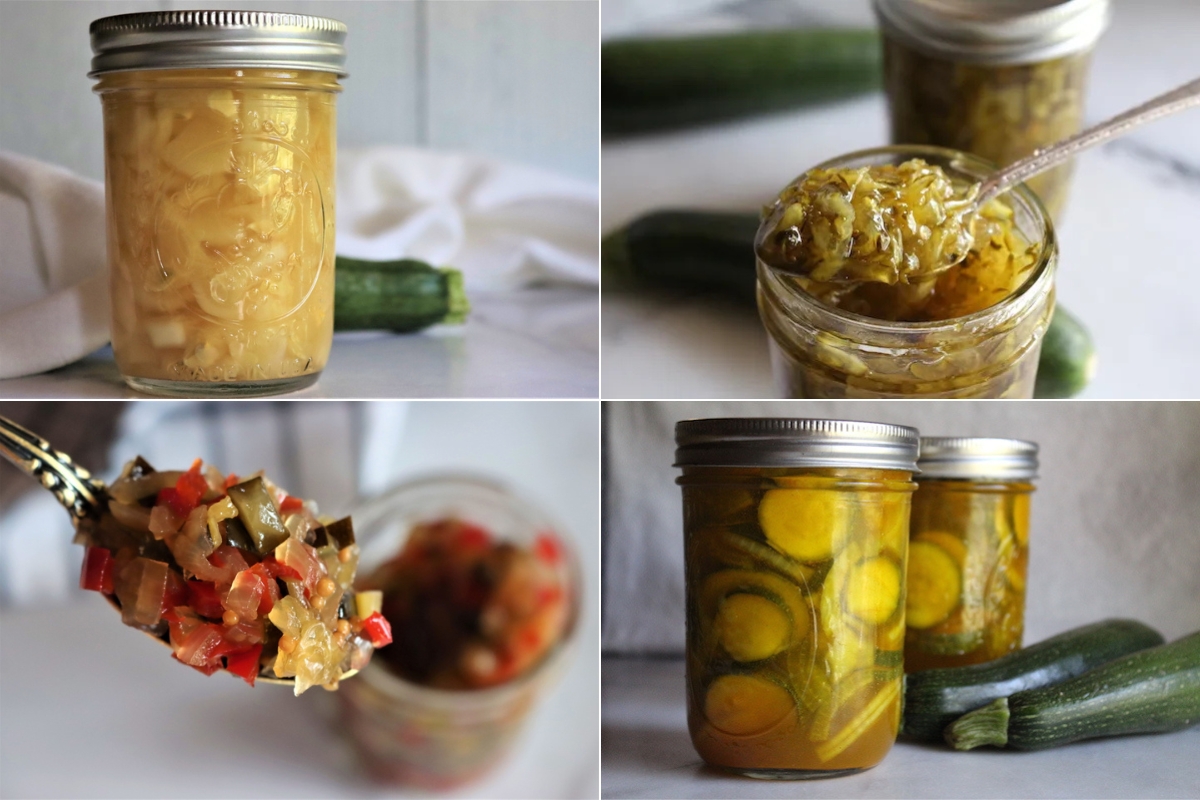
Having more zucchini than you know what to do with is a familiar feeling for most gardeners. Canning is one of the best ways to take care of an abundance of produce, and zucchini is no exception.
Most of these recipes were designed for water bath canning, and they use added acidity from things like lemon juice, pineapple juice or vinegar to bring the pH to a safe level for canning.
Pressure canning is also an option. While it’s not suitable for canning by itself, there are two safe tested recipes with zucchini and other vegetables.
There is no safe method for canning plain zucchini.
Why not?
Zucchini and all the other squashes we grow in the home garden are low-acid vegetables. This means that if you’re going to water bath can them, they must be canned with added acidity. Pressure canning is ideal for many low-acid vegetables like green beans and corn. Sadly, squashes are tricky to pressure can. The issue with zucchini and summer squash is that they tend to fall apart and turn to mush during the pressure canning process.
Not only is this unappealing, but it’s actually dangerous. As the zucchini breaks down and forms of thick mush or paste, it becomes difficult for the heat to penetrate adequately. This means the zucchini hasn’t been properly sterilized during the canning process and could harbor harmful bacteria like botulism. Pumpkin and winter squash are similar in that you cannot can them as a purée. Thankfully, they hold their shape a bit better, so you can process them as cubes.
Don’t give up hope yet! Just because you can’t process plain zucchini doesn’t mean there aren’t some tasty zucchini canning recipes.
It’s perfectly safe to can zucchini with added acidity. Recipes like relish, pickles, or even marmalade are ideal for water bath canning.

List of Zucchini Canning Recipes
You can try some really creative recipes like “zucchini pineapple,” which tastes almost exactly like canned pineapple. For this recipe, you water bath can your zucchini in pineapple juice, and the mild vegetable picks up all the juice’s flavor. It makes a pretty convincing Hawaiian pizza fresh from the farm in places like Vermont, where a pineapple would never grow.
Most of these recipes allow you to preserve zucchini as a condiment or pickle, which isn’t always ideal if you have zucchini coming out your ears. There are two safe ways to pressure can zucchini that are a bit more versatile. One of my favorites involves pressure canning zucchini with diced tomatoes.
Zucchini Pickles
If you’re already familiar with canning cucumber pickles, you already have the basic idea. Zucchini pickles are very similar. They’re sliced in jars with seasoning and a vinegar brine.
Cucumber pickles seem to be everyone’s favorite, but I actually prefer zucchini pickles. They stay firmer than cucumbers, and I like their texture a bit better. I also think zucchini has a stronger flavor on its own, so I find them more flavorful as pickles, too.
When you’re canning zucchini pickles, vinegar is the essential ingredient. To be safe for water bath canning, your zucchini pickles need to be in a brine that’s at least 50% vinegar (5% acidity). Depending on the recipe, you’ll also add salt, sugar, and seasonings, but these are all just for flavor. The vinegar is what keeps them safe.
My favorite recipe, is my bread and butter pickles recipe, which was traditionally for cucumbers. All I do is substitute the same amount of sliced zucchini for the sliced cucumber.
They’re the perfect balance of tangy and sweet. I love eating them on homemade burgers during our summer cookouts.
If bread and butter isn’t your thing, don’t worry; there are plenty of ways to pickle zucchini:
- Bread and Butter Zucchini Pickles
- Zucchini Dill Pickle from Grow a Good Life
- Spicy Zucchini Pickles from Bitter Salty Sour Sweet
- Pickled Mixed Vegetables from Bernardin
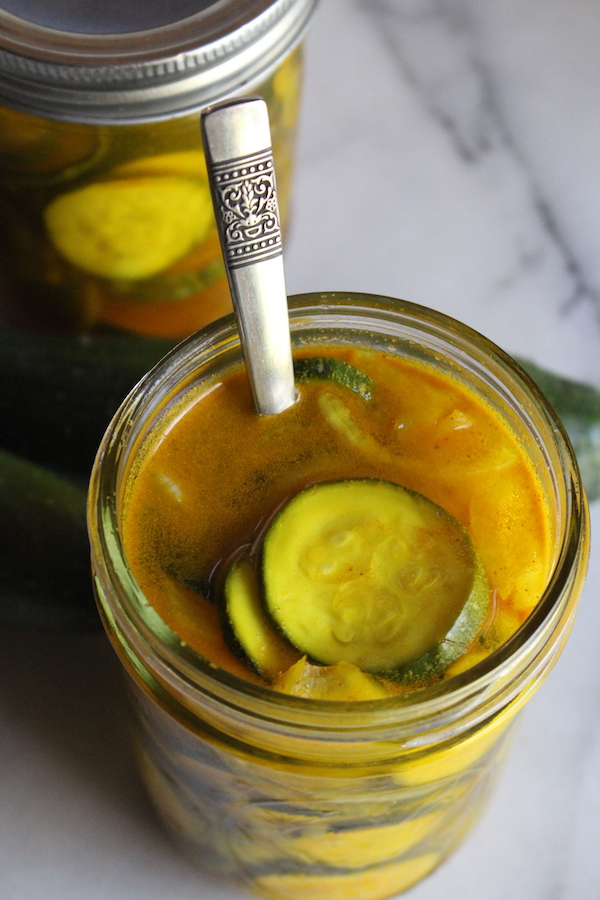
Zucchini Relish
Relish of any kind is one of the easiest canning recipes. You can use any surplus vegetable, including zucchini, dice it, and preserve it in a mixture of vinegar, salt, and sugar.
Most recipes also call for other low-acid ingredients like diced onion or red pepper. Since all these vegetables are low-acid, it’s important to stick to the proportions listed in the recipe.
All of the tested recipes for relish will include a good quantity of canning vinegar at a standardized 5% acidity. When buying vinegar, be sure to check the label carefully. Some vinegar now comes “pre-diluted” and may only be around 3% acidity. Using a less acidic vinegar could make your recipe unsafe for canning.
My favorite is this tested zucchini relish recipe from the Ball Blue Book Guide to Preserving. Another great option is a sweet brown relish called Ploughman’s Pickle from Healthy Canning. It’s great for English cheese and “pickle” sandwiches.
- Zucchini Relish from Ball Blue Book Guide to Preserving
- Ploughman’s Pickle from Healthy Canning
- Zippy Zucchini Relish from Healthy Canning
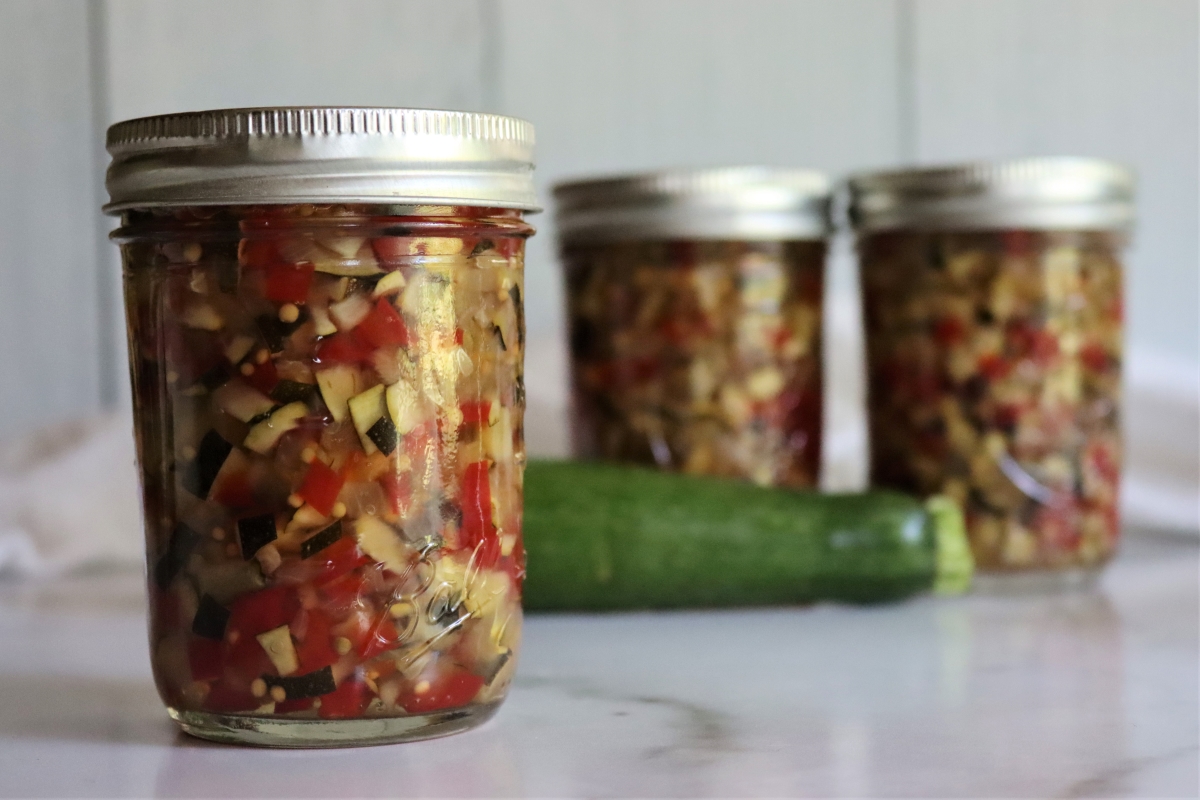
Vegetable Antipasto
Many people have seen antipasto in jars at the store and wonder if they can process it at home. Unfortunately, traditional antipasto is not safe for home canning.
This recipe is non-traditional but still offers excellent flavor. Do not alter or add ingredients to this recipe. Instead, add ingredients like mushrooms, olive oil, and salmon when you’re ready to serve.
Create a canning-safe vegetarian antipasto with this recipe from Bernardin.
Zucchini in Pineapple Juice
From brownies to guacamole, I’ve seen many recipes over the years where gardeners have tried to hide zucchini in a traditionally zucchini-free product. This canning recipe is probably the most creative and delicious I’ve found.
This is another excellent recipe from the Ball Blue Book Guide to Preserving. It suggests canning peeled zucchini chunks or shredded zucchini in pineapple juice. The National Center for Home Food Preservation has approved this recipe and lists zucchini pineapple as safe for canning.
The pineapple juice helps lower the zucchini’s acidity and adds sugar and flavor. When prepping for this recipe, you also want to purchase lemon juice. Despite pineapple juice being acidic, you still need to add lemon juice to bring the pH down even further.
Surprisingly, the finished product tastes exactly like pineapple with just a hint of zucchini.
I love using it in a carrot cake recipe that calls for crushed pineapple or zucchini bread. When making these two recipes, I use the shredded version and drain it before adding it.
The Ball Blue Book also has a mouthwatering recipe for pineapple zucchini donuts that uses canned shredded “zucchini pineapple.”
Make your own zucchini pineapple.
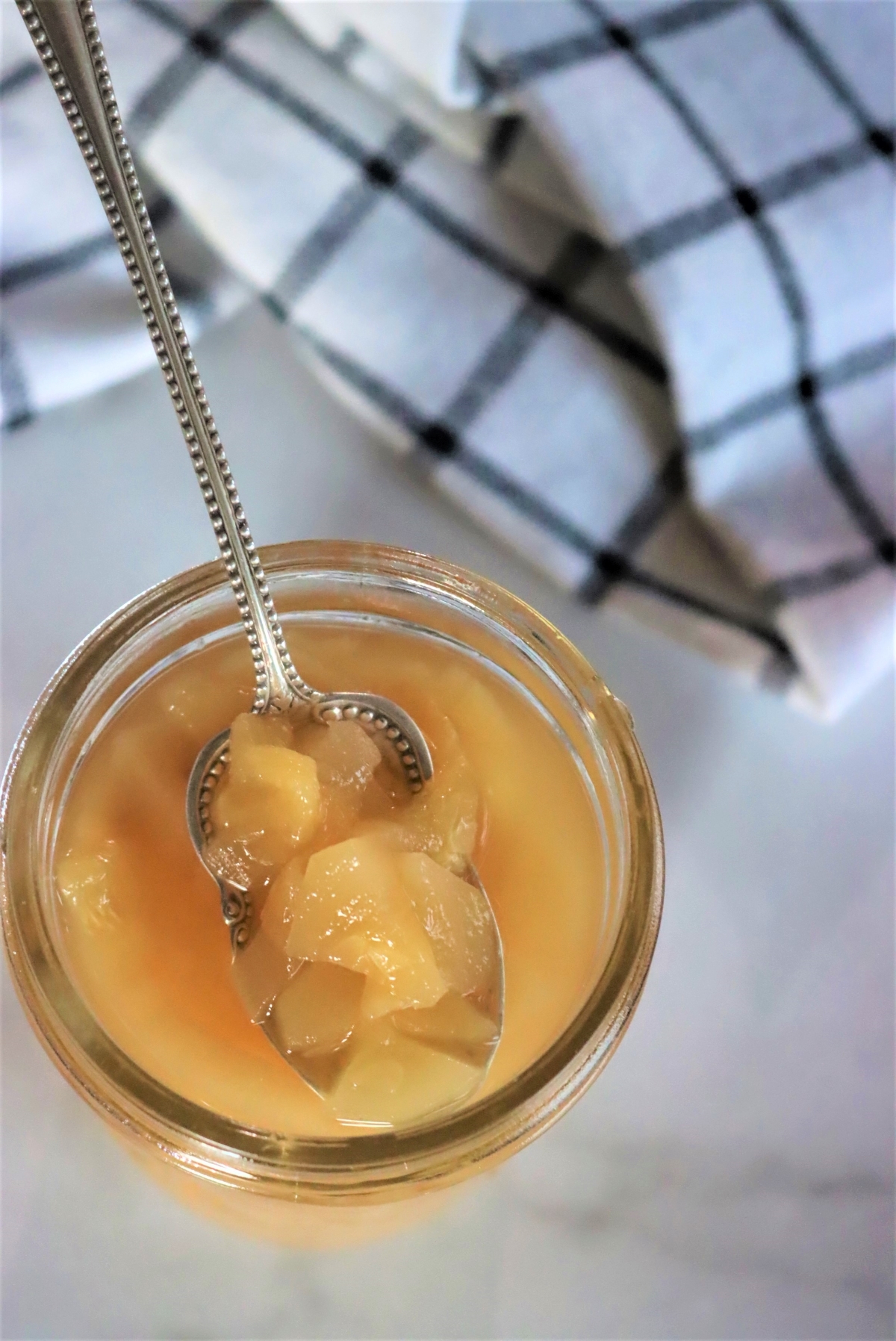
Zucchini Marmalade (Jam)
Zucchini marmalade isn’t the best recipe for using up an overabundance of zucchini, but it’s becoming one of my favorites anyway. It’s a simple recipe that tastes like zucchini bread with a bit of sweet lemon marmalade flavor from the addition of lemon juice and lemon zest. It also includes plenty of ginger, which helps give it that spiced flavor I’m looking for in a good zucchini bread.
As mentioned above, you don’t need a ton of zucchini, only a few small zucchini per batch. While I love the flavor, there’s only so much jam a family can eat. I always make a batch or two of zucchini marmalade, but it doesn’t use up the majority of our harvest.
The lemon zest and juice in the recipe lower the zucchini’s pH, making it safe for water bath canning. They both also contain natural pectin, meaning you don’t need boxed pectin for this jam recipe. It comes together with just a few simple ingredients.
- Lemon & Ginger Zucchini Marmalade from Practical Self Reliance
- Orange, Lemon, & Ginger Zucchini Marmalade from Bernardin
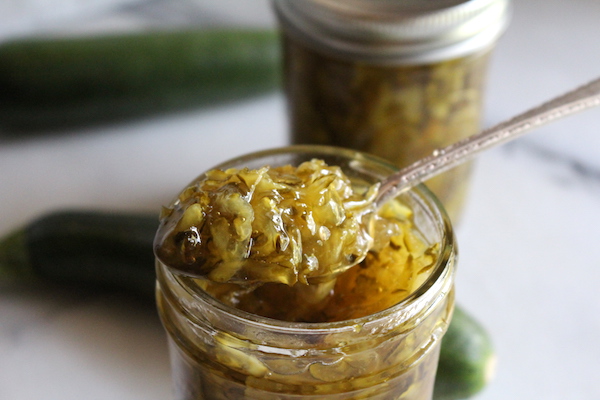
Canning Zucchini with Tomatoes
This recipe is great for adding to other meals later. However, you will need a pressure canner for this recipe.
(If you’ve never used a pressure canner before, I’d suggest reading this beginner’s guide to pressure canning before you begin.)
My family likes using this canned zucchini in casseroles, pasta dishes, stew, and vegetable soup. Unfortunately, for gardeners with stacks of zucchini on their counters, this recipe uses less zucchini than you might think.
The recipe calls for three parts peeled and diced tomatoes and one part zucchini. It’s almost more of a tomato canning recipe than a zucchini recipe.
Though the tomato helps acidify everything, this is still a pressure canning recipe. the chunks of tomato help prevent the zucchini cubes from breaking down into purée.
The National Center for Home Food Preservation has instructions for safely canning zucchini and tomatoes.
Canning Mixed Vegetables
Like the zucchini and tomatoes, this recipe requires a pressure canner.
The original recipe calls for carrots, lima beans, zucchini, sweet corn, green beans, and tomatoes but there are a few safe substitutions you can make to suit your family’s taste and produce availability.
On its own, these jars of mixed vegetables make a quick, nourishing side for any meal. You Can also combine them with meat or other ingredients to make quick soups and stews.
The National Center for Home Food Preservation has instructions for safely pressure canning mixed vegetables with zucchini.
Ways to Preserve Zucchini
Still need more ways to preserve your zucchini harvest?
Summer Canning Recipes
Have more abundance you need to preserve?
- Canning Peaches
- Canning Green Tomatoes
- Canning Corn
- Canning Whole Berries
- Canning Winter Squash & Pumpkin
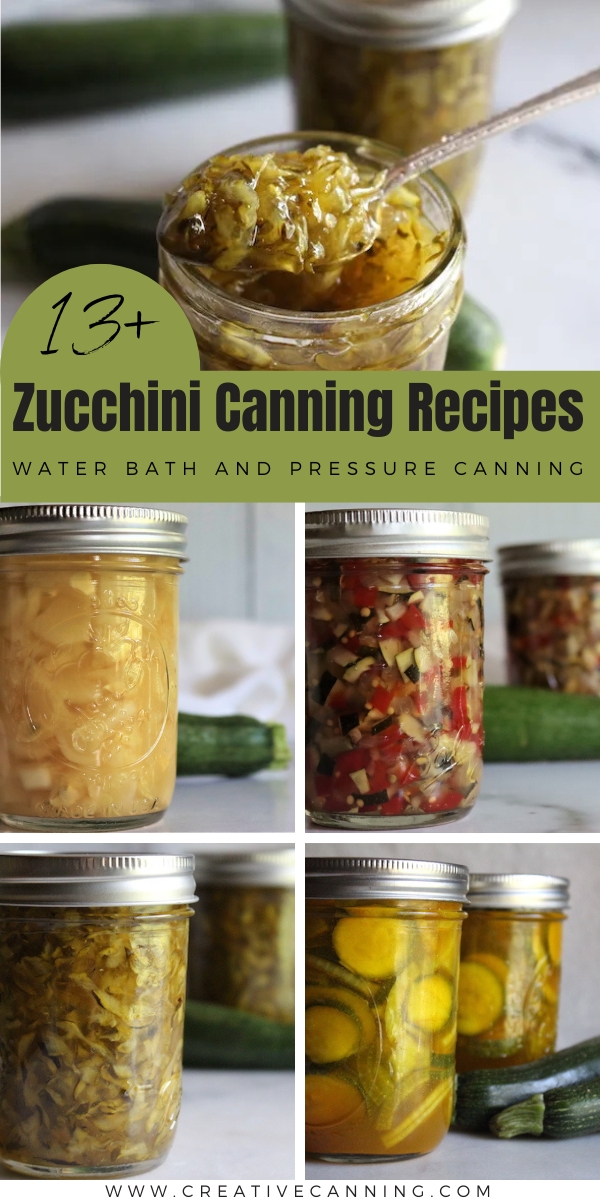

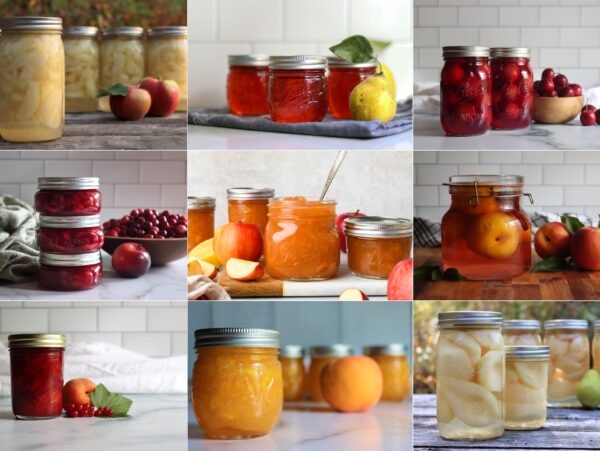

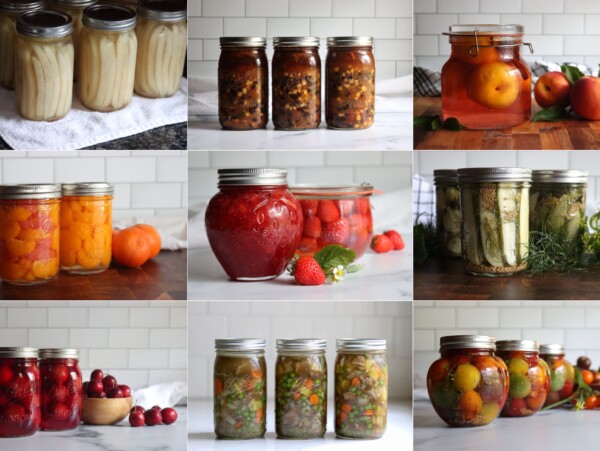
I tried the zucchini marmalade and it’s excellent! I plan on making multiple batch and giving out at the holidays along with a loaf of “pineapple” zucchini bread!
Thank you for the wonderful ideas and compilation!!
Lovely, so glad you liked it!
Thank you for all this information! I have squash “coming out of my ears” and these ideas are helpful and I am very excited to try them!
So glad to hear it!
I have some large zucchini squash that I am excited about because I frequently use it to make mock apple crisp, etc. I’d love to can some to use this winter. I was thinking I’d chunk up the squash and try a light sugar syrup, lemon juice and hot bath method. Is this safe and how much lemon juice would I need to use?
That does sound tasty, and it sounds like you’re basically trying to pickle the zucchini in lemon juice. This in particular is not tested, though as it says in the article there is a similar recipe for canning zucchini in pineapple juice.
That said, there is a pickling recipe for zucchini, and in pickling recipes, you’re always allowed to replace the vinegar with lemon juice because lemon juice is more acidic than vinegar. Pickling recipes require a 1:1 ratio of vinegar (in this case lemon juice) to water for safe preservation, so what you’d do is create a syrup that’s 1 cup water and 1 cup lemon juice, and then likely quite a bit of sugar. It’d be VERY lemon-y, but that’s the only way I can think of to accomplish what you’re going for in a way that follows current tested guidelines.
Hope this helps!